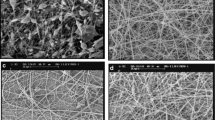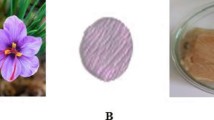Abstract
Alginate is a non-toxic, renewable, and linear copolymer obtained from the brown algae Laminaria digitata that can be easily shaped into beads. Its good gel forming properties have made it useful for entrapping food and pharmaceutical ingredients. In this study, alginate beads were used in a novel application as a colorimetric sensor in food intelligent packaging. Colorimetric sensor was developed through entrapping red cabbage extract as a pH indicator in alginate beads. The pH indicator beads were used in rainbow trout packaging for monitoring fillets spoilage. Color change of beads during fish storage was measured using the CIELab method. The alginate bead colorimetric sensor is validated by measuring total volatile basic nitrogen (TVB-N) levels and microbial populations in fish samples. Moreover, peroxide value (PV) and thiobarbituric acid reactive substances (TBARS) were evaluated during storage. Results indicated that increasing the bacterial population during storage and production of proteolytic enzymes resulted in protein degradation, accumulation of volatile amine compounds, increase in the pH and finally color change of alginate beads. The values of TVB-N, pH, PV and TBARS increased with time of storage. The results of TVB-N and microbial growth were in accordance with color change of beads and CIELab data. Therefore, the proposed system enjoys a high sensitivity to pH variations and is capable of monitoring the spoilage of fish or other protein-rich products through its wide range of color changes. The alginate beads containing the red cabbage extract can, thus, be used as a low-cost colorimetric sensor for intelligent packaging applications.




Similar content being viewed by others
References
Abolghasemi MM, Sobhi M, Piryaei M (2016) Preparation of a novel green optical pH sensor based onimmobilization of red grape extract on bioorganic agarose membrane. Sens Actuators B Chem 224:391–395
Alimelli A, Pennazza G, Santonico M, Paolesse R, Filippini D, D’Amico A, Lundström I, Di Natale C (2007) Fish freshness detection by a computer screen photoassisted based gas sensor array. Anal Chim Acta 582:320–328
Azarakhsh N, Osman A, Ghazali HM, Tan CP, Adzahan NM (2014) Effects of gellanbased edible coating on the quality of fresh-cut pineapple during refrigerated storage. Food Bioprocess Technol 7:2144–2151
Babu VR, Sairam M, Hosamani KM, Aminabhavi TM (2007) Preparation of sodium alginate–methylcellulose blend microspheres for controlled release of nifedipine. Carbohydr Polym 69:241–250
Branyik T, Vicente AA, Dostalek P, Teixeira JA (2005) Continuous beer fermentation using immobilized yeast cell bioreactor systems. Biotechnol Prog 21:653–663
Cai L, Wu X, Dung Z, Li X, Yi S, Li J (2014) Physicochemical responses and quality changes of red sea bream (Pagrosomus major) to gum arabic coating enriched with ergothioneine treatment during refrigerated storage. Food Chem 160:82–89
Chung SWC, Chan BTP (2009) Trimethylamine oxide, dimethylamine, trimethylamine and formaldehyde levels in main traded fish species in Hong Kong. Food Addit Contam Part B 2:44–51
Cristina Silva-Pereira M, Augusto Teixeira J, Aniceto Pereira-Júnior V, Stefani R (2015) Chitosan/corn starch blend films with extract from Brassica oleraceae (red cabbage) as a visual indicator of fish deterioration. LWT Food Sci Technol 61:258–262
Da Silva MA, Bierhalz ACK, Kieckbusch TG (2009) Alginate and pectin composite films cross-linked with Ca2+ ions: effect of the plasticizer concentration. Carbohydr Polym 77:736–742
Fernandez J, Perez-Alvarez IA, Fernandez-Lopez JA (1997) Thiobarbituric acid test for monitoring lipid oxidation in meat. Food Chem 59:345–353
Frangos L, Pyrgotou N, Giatrakou V, Ntzimani A, Savvaidis IN (2010) Combined effects of salting, oregano oil and vacuum-packaging on the shelf-life of refrigerated trout fillets. Food Microbiol 27:115–121
Ghaly AE, Dave D, Budge S, Brooks MS (2010) Fish spoilage mechanisms and preservation techniques: review. Am J Appl Sci 7:859–877
Giatrakou V, Kykkidou S, Papavergou A, Kontominas MG, Savvaidis IN (2008) Potential of oregano essential oil and MAP to extend the shelf life of fresh swordfish: a comparative study with ice storage. J Food Sci 73:167–173
Gil L, Barat JM, Garcia-Breijo E, Ibañez J, Martínez-Máñez R, Soto J, Llobet E, Brezmes J, Aristoy MC, Toldrá F (2008) Fish freshness analysis using metallic potentiometric electrodes. Sens. Actuators B Chem 131:362–370
Goulas AE, Kontominas MG (2005) Effect of salting and smoking-method on the keeping quality of chub mackerel (Scomber japonicus): biochemical and sensory attributes. Food Chem 93:511–520
Gram L, Huss HH (1996) Microbiological spoilage of fish and fish products. Int J Food Microbiol 33:121–137
Harper BA, Barbut S, Lim L, Marcone MF (2014) Effect of various gelling cations on the physical properties of “wet” alginate films. J Food Sci 79:562–567
Huang X, Xin J, Zhao JJ (2011) A novel technique for rapid evaluation of fish freshness using colorimetric sensor array. J Food Eng 105:632–637
Ibrahim Sallam K (2007) Antimicrobial and antioxidant effects of sodium acetate, sodium lactate, and sodium citrate in refrigerated sliced salmon. Food Control 18:566–575
International Commission on Microbiological Specifications for Foods (ICMSF) (1986) Sampling plans for fish and shellfish, ICMSF, Microorganisms in foods, second ed. Sampling for microbiological analysis: principles and scientific applications, vol 2. University of Toronto Press, Toronto, pp 181–196
Jouki M, Tabatabaei Yazdi F, Mortazavi SA, Koocheki A, Khazaei N (2014) Effect of quince seed mucilage edible films incorporated with oregano or thyme essential oil on shelf life extension of refrigerated rainbow trout fillets. Int J Food Microbiol 174:88–97
Klock G, Pfeffrmann A, Ryser C, Grohn P, Kuttler B, Hahn HJ, Zimmermann U (1997) Biocompatibility of mannuronic acid-rich alginates. Biomaterials 18:707–713
Kuswandi B, Restyana A, Abdullah A, Heng LY, Ahmad M (2012) A novel colorimetric food package label for fish spoilage based on polyaniline film. Food Control 25:184–189
Morsy MK, Zor K, Kostesha N, Sonne Alstrøm T, Heiskanen A, El-Tanahi H, Sharoba A, Papkovsky D, Larsen J, Khalaf H, Jakobsen MH, Emnéus J (2016) Development and validation of a colorimetric sensor array for fish spoilage monitoring. Food Control 60:346–352
Natale CD, Olafsdottir G, Einarsson S, Martinelli E, Paolesse R, D’Amico A (2001) Comparison and integration of different electronic noses for freshness evaluation of cod-fish fillets. Sens Actuators B Chem 77:572–578
Nguyen LT, Lau YS, Yang KL (2016) Entrapment of cross-linked cellulase colloids in alginate beads forhydrolysis of cellulose. Colloid Surf B 145:862–869
Ojagh SM, Rezaei M, Razavi SH, Hosseini SMH (2010) Effect of chitosan coatings enriched with cinnamon oil on the quality of refrigerated rainbow trout. Food Chem 120:193–198
Pacquit A, Lau KT, McLaughlin H, Frisby J, Quilty B, Diamond D (2006) Development of a volatile amine sensor for the monitoring of fish spoilage. Talanta 69:515–520
Pacquit A, Frisby J, Diamond D, Lau K, Farrell A, Quilty B (2007) Development of a smart packaging for the monitoring of fish spoilage. Food Chem 102:466–470
Pawar SN, Edgar KJ (2012) Alginate derivatization: a review of chemistry, properties and applications. Biomaterials 33:3279–3305
Prietto L, Mirapalhete TC, Pinto VZ, Hoffmann JF, Vanier NL, Lim LT, Guerra Dias AR, Zavareze EDR (2017) pH-sensitive films containing anthocyanins extracted from black bean seed coat and red cabbage. LWT Food Sci Technol 80:492–500
Raeisi M, Tajik H, Aliakbarlu J, Mirhosseini SH, Hosseini SMH (2015) Effect of carboxymethyl cellulose-based coatings incorporated with Zataria multiflora Boiss. essential oil and grape seed extract on the shelf life of rainbow trout fillets. LWT Food Sci Technol 64:898–904
RØrvik KA, Steien SH, Saltkjelsvik B, Thomassen MS (2000) Urea and trimethylamine oxide in diets for seawater farmed rainbow trout: effect on fat belching, skin vesicle, winter ulcer and quality grading. Aquacult Nutr 6:247–254
Souza BWS, Cerqueira MA, Ruiz HA, Martins JT, Casariego A, Teixeira JA, Vicente AA (2010) Effect of chitosan-based coatings on the shelf life of salmon (Salmo salar). J Agric Food Chem 58:11456–11462
Tassanawat S, Phandee A, Magaraphan R, Nithitanakul M, Manuspiya H (2007) pH-sensitive PP/clay nanocomposites for beverage smart packaging. In: Proceedings of the 2nd IEEE international, conference on nano/micro engineered and molecular systems
Verbelen PJ, De Schutter DP, Delvaux F, Verstrepen KJ, Delvaux FR (2006) Immobilized yeast cell systems for continuous fermentation applications. Biotechnol Lett 28:1515–1525
Won K, Kim S, Kim KJ, Park HW, Moon SJ (2005) Optimization of lipase entrapment in Ca-alginate gel beads. Process Biochem 40:2149–2154
Acknowledgements
The authors would like to acknowledge Shiraz University for their financial support.
Funding
This study was funded by Shiraz University.
Author information
Authors and Affiliations
Corresponding author
Ethics declarations
Conflict of interest
Authors declare that they have no conflict of interest.
Research involving human participants and/or animals
This article does not contain any studies with human participants performed by any of the authors.
Rights and permissions
About this article
Cite this article
Majdinasab, M., Hosseini, S.M.H., Sepidname, M. et al. Development of a novel colorimetric sensor based on alginate beads for monitoring rainbow trout spoilage. J Food Sci Technol 55, 1695–1704 (2018). https://doi.org/10.1007/s13197-018-3082-5
Revised:
Accepted:
Published:
Issue Date:
DOI: https://doi.org/10.1007/s13197-018-3082-5




